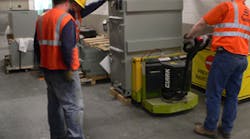Because buildings in the financial district of Chicago’s downtown area are going through their second or third generation of tenants, turnover often translates into revamping office space and reevaluating electrical needs — a process that escalates over time. In addition, the dimensions of new electrical equipment designed to meet the need for this increased capacity exceed the openings of the buildings in which they’re going to be installed, increasing the cost and complexity of the installation. So when the 40-story, twin tower Chicago Mercantile Exchange Building (CME) needed a power makeover, it turned to Cooper Power Systems, a division of Cooper Industries based in Waukesha, Wis., for answers.
Recently installing its first Triplex Indoor Power Center (IPC) at the CME, the installation is designed so that a building tenant might expect to see a 35% reduction in energy costs, up to a 20% reduction in HVAC costs, up to a 50% noise reduction level, and has 50% higher short term overload capacity compared to traditional indoor equipment choices.
“Today’s building owners and managers are under intense pressure to reduce energy and HVAC costs, eliminate noise, and provide tenants with an increased amount of electrical power,” says Steve Benna, vice president, commercial/industrial sales and marketing, Cooper Power Systems. “Cooper’s Triplex IPC achieves those goals by taking advantage of the fire-resistant properties of FR3 dielectric fluid to permit installation in limited space areas, delivering measurable value to building owners before the power is even turned on.”
The modular design of the Triplex IPC not only gives architects and building owners the power their tenants need, but it provides them with the flexibility necessary to get into electric rooms and other spaces by way of existing service elevators and hallways, optimizing the time needed for office re-designs and minimizing the need for building modifications.
“This is a significant evolution in technology that provides an attractive, higher-efficiency alternative to dry-type transformers,” says Chad Mendell, vice president, Environmental Systems Design, Chicago. “Its value will be restated every time users receive an electric bill.”




